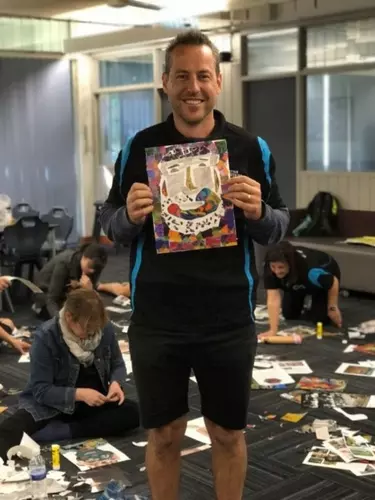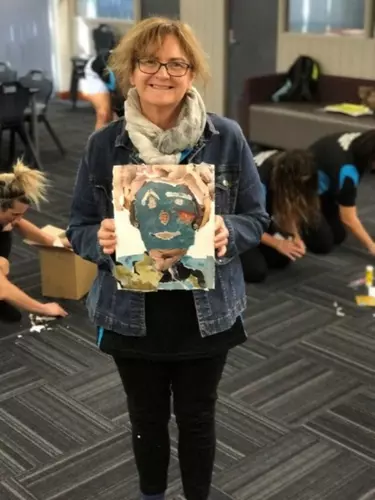Creative Leadership in Learning Case Studies
Transforming teaching: Casula High School
Casula High School began their partnership with Creative Leadership In Learning (CLIL) in 2017 with a specific intent. Their first year of the program would focus entirely on professional learning for the teaching staff and school leaders.
PE and Special Education teacher Andrew Walsh, who has since become the CLIL project leader within the school, recalls how significant this became for the Casula staff, students and community.
“One of the keys to how successful Creative Leadership In Learning has been at Casula is that we had all the senior executives with us at the beginning,” he says. “Our three deputies, our principal at the time and seven teachers who all began the journey.”



Gareth Smith, Principal, Bonnie Griffin, Head Teacher CAPA, Jenny French, Former Principal.
While the individual projects in each school are different, the consistent driver of inquiry is based around a single focus question developed by the school. At Casula this is: “How can we embed creativity into the programming of all KLAs [Key Learning Areas] across the school?”. With this question at the forefront of their minds the group began working with Opera House Creative Learning Specialist Frank Newman and artist Lilly Blue in 12 master classes.
Exploring notions of creativity through physical theatre, visual art and artistic process exercises, and bolstered by a training day at the Opera House, the teachers discovered and developed ways of engaging creativity within the classroom.
Crucially, it was when the group then collaborated with each school faculty to work out how to use these new ideas for different subjects that Casula’s teaching transformation began.
“This meant that every year these things we learned are getting used,” Andrew says. “And they're getting used commonly around the school, no matter what subject the students are in.
“Students will be, or have been, exposed to the activities and strategies on a regular basis and that has made this whole process really successful at our school.
It has revolutionised teaching and learning at Casula High School.
In the following two years, as teachers and school leaders continued a strong focus on professional learning, students began creative projects with artists. In 2018, theatre artist Jane Grimley, and teacher Emily Signorini, worked with Year 10 STEM students exploring the theme “tragedy as a provocation for design in STEM”, creating a stage work presented at the Opera House in a combined show with performances by Liverpool High School.
One of the Casula High's proudest outcomes came from the students of the 20 Special Education Unit who worked with artist Howard Matthew throughout 2018 to create a film titled Voyage to our Future. Delving into their hopes and fears for the future, it explored what life might hold after finishing school and leaving the care of the unit.
Voyage To Our Future.
Created by students of the 20 Special Education Unit who worked with artist Howard Matthew.
The school has also developed creativity classes for students in Year 7 as a way to help them transition to high school and understand new and different ways of learning after primary school.
Of all the positive effects of the program, Andrew’s strongest memories come from students presenting work on the Opera House stage to family, friends and teachers.
We targeted different groups from around the school and gave them that exposure, which, for a lot of our students with low socio-economic backgrounds, has been a significant step,” he says. “They’d never been to the city or to the Opera House before. They’d literally never seen the Harbour Bridge.
“Getting to travel in there and have their family and friends invited, it's a huge deal for them. To this day, students who graduated from our Special Ed unit last year still come back and talk about that day and night, which is unreal.”
The transformative effect on teachers has been equally momentous. Opera House Creative Learning Specialist Frank Newman recalls teachers feeling dubious and questioning the process in the early days of the professional learning master classes he and Lilly Blue led.
“For teachers taking the program it’s big,” Frank says. “Often they're taking huge risks, trying things, making art for the first time since they were in primary school.
“Quite often they walk into the first session, and they'll go, ‘Oh listen, I'm right up for this but I'm just letting you know, I'm not at all creative’. Almost every time in each new school, or each new group inside a school, someone says that “And I go, ‘Oh, that's fine, thanks. You're wrong. You are creative just by virtue of being a human being. You just haven’t flexed those muscles for a while’.
“Then they end up doing all sorts of wonderful, weird, beautiful things and challenging themselves. It’s a real journey for them. I’m as proud of the work CLIL does with teachers as I am of the work with the students. While the joy on student faces is incredibly obvious to everyone involved with the program, the positive impact and changes on teachers are there – just far less visible.”
Andrew believes the CLIL program, and the effect of implementing it across all of Casula High School’s faculties, gives every teacher a new confidence and motivation.
“There’s not a negative part to it,” he says. “In my opinion it changes teaching and it change students' learning for the better. We’ve been working to make sure it’s sustainable and part of the school for a long time.”
Find more about Creative Leadership in Learning

